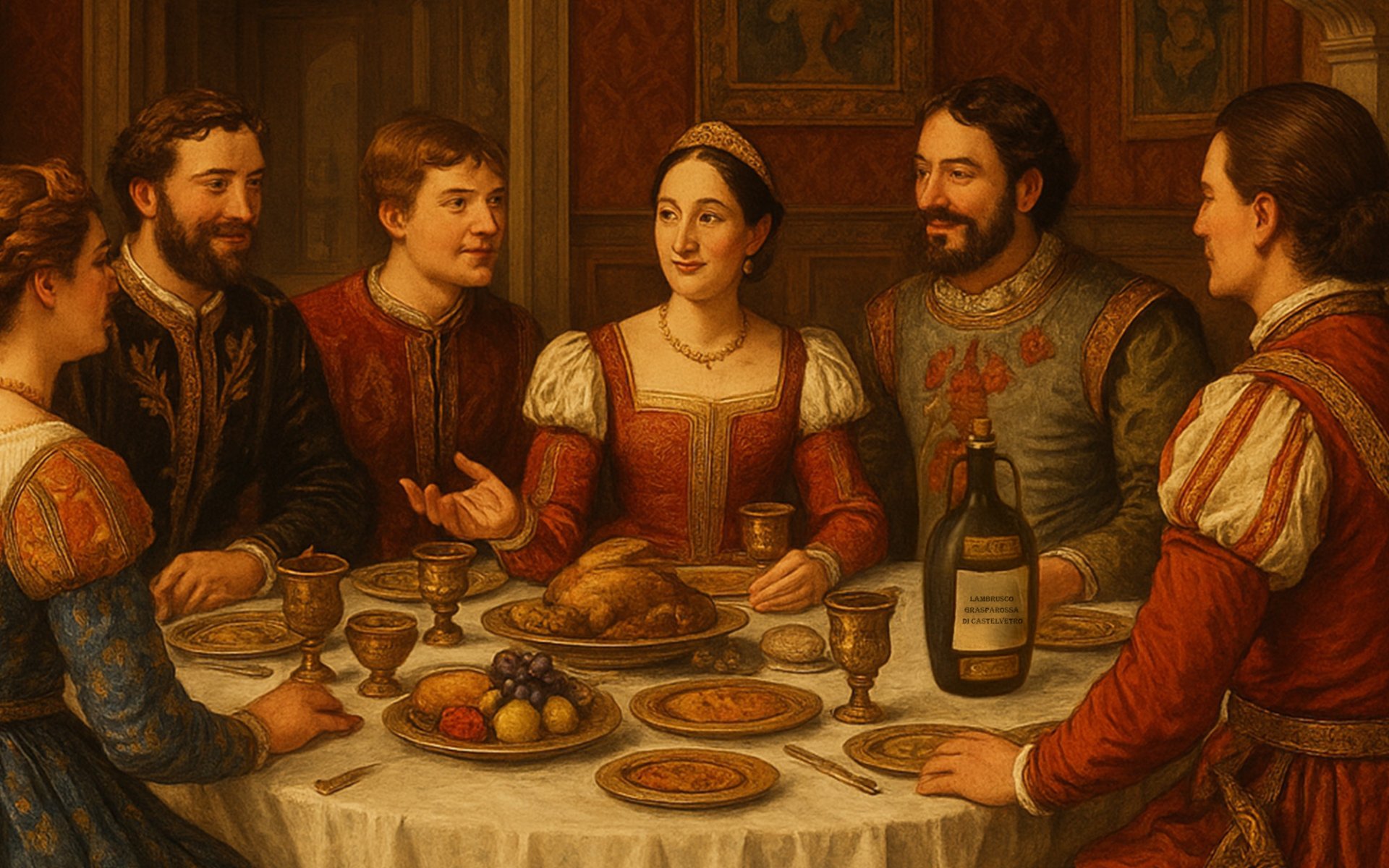Lambrusco
Last updated: 8 Sept 2025

Lambrusco is a sparkling wine originating from the Emilia-Romagna region in northern Italy. Made from the Lambrusco grape variety, the wine is known for its unique balance of sweet and tart flavors, gentle effervescence, and fragrant aromas of fruits such as cherry, strawberry, and other berries.
Early Lambrusco wines were made from wild Lambrusco grapes, long before organized viticulture. The production method was quite different from todays techniques. The wine underwent secondary fermentation in tightly sealed containers, then was stored underground or in cool water to maintain low temperatures. This process naturally created bubbles in the wine. After a brief resting period, the wine was ready to drink within days.
Winemakers gradually improved production methods, refining grape varieties and fermentation techniques. By this time, Lambrusco began to resemble the modern styles we know today.
During the Renaissance, Emilia-Romagna became a cultural and artistic hub of Italy, and Lambrusco gained popularity among the nobility. It was frequently served at banquets hosted by wealthy families and influential leaders, which helped spread its reputation across Italy.
However, overproduction eventually harmed its reputation. Many producers prioritized quantity over quality, and Lambrusco became associated with being a cheap, low-quality wine.
Lambruscos effervescence makes it an excellent palate cleanser, cutting through the richness of fatty foods. It pairs beautifully with salumi, Prosciutto di Parma, and Parmigiano Reggiano cheese, refreshing the palate after each bite.
Beyond Italian cuisine, Lambruscos versatility allows it to complement a wide range of international dishes, including Thai sweet-and-sour dishes, lighter Chinese cuisine, Japanese sushi and sashimi, grilled sausages, and roasted fish.
Ancient Origins
The origins of Lambrusco date back to the ancient Etruscans, a civilization that flourished in parts of Italy before the Roman era, as early as the 7th century BC. The Lambrusco grape is one of the oldest varieties known, and it is believed that the Etruscans were the first to produce Lambrusco wine.Early Lambrusco wines were made from wild Lambrusco grapes, long before organized viticulture. The production method was quite different from todays techniques. The wine underwent secondary fermentation in tightly sealed containers, then was stored underground or in cool water to maintain low temperatures. This process naturally created bubbles in the wine. After a brief resting period, the wine was ready to drink within days.
Roman Era Popularity
During the Roman Empire, Lambrusco became widely popular. The Roman naturalist Pliny the Elder mentioned Lambrusco grapes in his writings, noting their widespread cultivation for producing intensely fruity wines with natural effervescence. The sparkling quality, created through fermentation in jars, made Lambrusco a favorite among Romans.Medieval and Renaissance Periods
In the Middle Ages, Lambrusco was the everyday drink of people in Emilia-Romagna, especially farmers, due to its affordability. The wines were light, fizzy, and paired well with local staples like cured meats, cheese, and pasta.Winemakers gradually improved production methods, refining grape varieties and fermentation techniques. By this time, Lambrusco began to resemble the modern styles we know today.
During the Renaissance, Emilia-Romagna became a cultural and artistic hub of Italy, and Lambrusco gained popularity among the nobility. It was frequently served at banquets hosted by wealthy families and influential leaders, which helped spread its reputation across Italy.
Industrialization and Export
The 19th century brought industrial-scale production. Lambrusco began to be exported to other parts of Europe and to the Americas. Its approachable flavors and refreshing bubbles made it particularly popular in the United States.However, overproduction eventually harmed its reputation. Many producers prioritized quantity over quality, and Lambrusco became associated with being a cheap, low-quality wine.
Modern Revival
In recent decades, Lambrusco has experienced a renaissance. Winemakers in Emilia-Romagna have combined traditional methods with modern technology to produce high-quality wines with better-controlled fermentation. This has led to a diverse range of Lambrusco styles, from dry and tannic to sweet and fruity, each with distinct characteristics:- Lambrusco di Modena Rich, sweet-tart flavor with fine bubbles.
- Lambrusco di Sorbara Lighter and drier, with delicate effervescence.
- Lambrusco Grasparossa di Castelvetro The boldest style, with red fruit aromas, medium bubbles, and higher tannins. Perfect with red meats.
- Lambrusco Salamino di Santa Croce Sweet-tart with ripe fruit notes, ideal as an aperitif or paired with desserts.
Serving and Pairing
To enjoy Lambrusco at its best, serving temperature is crucial. It should be served well-chilled between 7°C and 13°C. Chilling the wine for 12 hours in the refrigerator enhances its freshness and highlights its fruity notes. Using the proper wine glass also helps retain its bubbles and aroma.Lambruscos effervescence makes it an excellent palate cleanser, cutting through the richness of fatty foods. It pairs beautifully with salumi, Prosciutto di Parma, and Parmigiano Reggiano cheese, refreshing the palate after each bite.
Beyond Italian cuisine, Lambruscos versatility allows it to complement a wide range of international dishes, including Thai sweet-and-sour dishes, lighter Chinese cuisine, Japanese sushi and sashimi, grilled sausages, and roasted fish.
Tags :
Related Content
Tracing the History of Southern Comfort: The Smooth, Fruity Whiskey from New Orleans, USA
Tracing the Legacy of Australian Shiraz The Red Wine That Redefined New World Winemaking


